Abstract
There is a lack of knowledge of the interactions required over time among the members of a building project design team. Without a specific target, it is impossible to identify gaps to propose improvement plans in the coordination and management of projects in the early stages. Therefore, this study proposes a model of the required interaction among the members of a building project design team during the different phases of the design process. The research was divided into three stages: (1) design team interactions; (2) construction of ideal interaction networks and proposed evaluation model; and (3) pilot cases—evaluation and analysis. Through this study, eight ideal networks were constructed, four for each interaction (information flow, collaboration, and coordination) and one for each design phase. In addition, a series of metrics were proposed to evaluate the current state of a building project, which, together with the constructed model networks, allowed the development of an evaluation method for real projects. Finally, two pilot cases were used to exemplify the use of the proposed model tool.
MSC:
91D30
1. Introduction
Design teams play an important role in the architecture, engineering, and construction (AEC) industry because they create design concepts and align client requirements to the project prior to the planning phase [1]. This process is complex and must be carefully managed to bring together and benefit the different stakeholders and organizations [2,3]. The type of professionals in construction projects is varied at different stages during the project life cycle, and, consequently, there is a high level of fragmentation in the division of tasks and responsibilities [4,5]. It is known that the effectiveness levels of design teams in the AEC industry are directly related to teamwork, which is reinforced in multidisciplinary design teams where members have specific skills to perform different tasks [6].
Even though there is a tendency to think that the wide diversity of specialties provides great opportunities for increased creativity and innovation [7], the AEC industry has been criticized for its fragmented approach to project delivery and its poor ability to form effective teams [8]. Even though fragmentation generates a high level of specialization of each of the parts, integrating the different specialties becomes complex as the number of parts into which the work is broken down increases, thus requiring a better interaction between them [9]. A change to this system promotes collaboration and new methods, where building information modeling (BIM) and lean construction are seen as enablers for integrated processes [2].
During the design phase, coordination is related to the flow of information because if poorly managed, designers suffer from information overload. In these cases, increasing the flow reduces the efficiency and effectiveness of communication [10]. Thus, for a design team to be successful, the participants must have high levels of interaction [11], which is aligned with efficient collaboration and communication that is fundamentally based on the shared understanding of team members [12]. Collaborative and multidisciplinary design processes enable effectiveness and responsiveness to market challenges [13].
Distributed work teams in different locations are an increasingly common feature of engineering design work; therefore, a shared understanding must be developed [14]. This is why interactions, in particular, efficient and systematic information flows between designers, become essential to achieving design objectives [15]. The interaction of a work team is generated through communication, coordination, and collaboration among the participants [16]. A low level of interaction directly impacts project performance [17]. This phenomenon is particularly important because the design stage is fundamental in the life cycle of a project, since decisions made in this phase can significantly affect subsequent phases. On the other hand, the cost of making changes earlier is negligible compared to the cost of changes in future stages [18].
Interactions and the realignment of components in a network have been studied to show how these dynamics affect the networks’ performance [19]. To analyze team interactions, different tools can be used, including social network analysis (SNA) [20]. Different types of interactions can be measured through the SNA: global interactions [21], relevant work information flow [22], and collaboration [11], among others. As there is a wide range of interactions, it is not easy to maintain optimal control. It is necessary to determine which interactions are most relevant to design teams and thus optimize efforts in the relationships that strongly impact performance. Galáz et al. [23] determined that the most relevant problems or challenges within design team interactions arise in communication, collaboration, coordination, trust, and role identification among team members. Therefore, if high-performance teams are to be achieved, these are the most relevant interactions to control and manage.
Recently, a study was conducted on social network analysis (SNA) in the construction sector [24]. To gain a better understanding of network formation and its application in the development of construction teams, the study explores three models of social network formation, with a focus on contrasting random, small-world, and truncated scale-free networks. The study reveals that construction project teams exhibit characteristics of small-world networks due to the clusters formed by contractual, professional, task, or economic links. Additionally, social networks are employed to comprehend the interactions among team members, as they encompass informal social connections [24]. The success of a team relies on the high level of interaction among its members. Various methods, such as electronic badges, BIM logs, emails, and surveys, are used to assess these interactions using social network analysis (SNA) from a multidimensional perspective. Each aspect of interaction is represented as a separate network, which can be analyzed individually. However, it is also important to examine the interconnections between two or more networks. The practical applications of employing SNA to study the relationships among multiple teams include (a) gaining comprehensive insights into team interactions from various perspectives, (b) optimizing interactions to enhance efficiency and reduce dependence on a single individual, (c) identifying factors contributing to common misunderstandings within teams, and (d) proactively addressing role expectations. These advantages enable project teams to better comprehend project requirements, minimize waste, and enhance the value of design and construction processes. Therefore, SNA serves as a crucial tool for evaluating work environments and interactions during the implementation of different new methodologies in the AEC industry. Furthermore, it should be employed as a tool for continual improvement rather than a punitive mechanism by both the assessment team and the evaluated team [25]. However, the use of social network interaction maps has been limited to diagnosis [21], improvement recommendation [26], and the simulation [27] of their impact on performance, without considering the required, engaged, or ideal interactions within a construction project design team.
In summary, although the strategies above and tools make it possible to diagnose the interaction flows between people, there is a lack of knowledge of the interactions required over time among the members of a building project design team. In the absence of a goal or required conditions, applying these mechanisms does not allow the identification of gaps to propose improvement plans in the coordination and management of projects in the early stages. Therefore, this research proposes a model of interaction required among the members of a building project design team throughout its different phases. To achieve this goal, this research considers the following contributions:
- Eight ideal networks were constructed, four for each interaction (information flow, collaboration, and coordination) and one for each design phase.
- A series of metrics proposed by the researchers were constructed, which allow for obtaining clear parameters of comparison when evaluating real projects.
- Given the need to understand the social interaction phenomena desirable in a building project design team so that, with real project information, continuous improvement of the coordination process can be achieved, two pilot cases exemplifying the use of the proposed model tool have been used.
2. Materials and Methods
The research was divided into three stages: (1) design team interactions; (2) construction of ideal interaction networks and proposed evaluation metrics; and (3) pilot cases—evaluation and analysis. Figure 1 shows the activities, research tools, and deliverables for each stage.
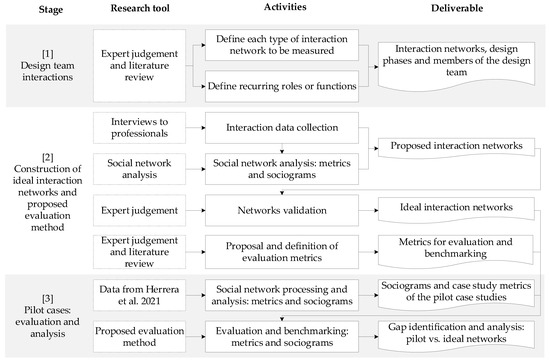
Figure 1.
Research approach.
2.1. Stage 1. Design Team Interactions
A literature review on construction design teams and their interactions was conducted, focusing on the application of SNA. Three aspects were considered: (a) the phases of the design stage of a building project; (b) the key or recurring members, roles, or functions in design teams; and (c) the most significant types of interaction. The search was conducted in specialized journals and conference proceedings published between 2010 and 2021. The research was conducted in Scopus and Web of Science libraries. The search strategy used was to search for information obtained in the “title, abstract and keywords” of the following reference topics: “design team”, “collaboration”, “team interaction”, “building”, “construction”, and “social network analysis”. The articles were selected by applying the following inclusion/exclusion criteria: (1) focus on building/construction engineering design; (2) focus on design teams; and (3) journals related to the AEC industry. Then, a virtual workshop complemented the literature review with nine professionals (Table 1). The workshop lasted ninety minutes, during which the aspects identified in the literature review were discussed and validated.

Table 1.
Characterization of the professionals participating in the workshop.
In the workshop, the researchers proposed the relevant phases, roles, and interactions to the participants. The participants discussed the information until a consensus was reached, and the phases, roles, and interactions to be developed in this research were finally defined. In addition, the ten most relevant issues identified by the study of [23] were presented. Each professional made his or her judgment, indicating the level of importance and the different effects that each of them implies in the design process. Then, to determine the recurring roles and functions in the design teams, a common framework was defined to narrow the field of study. In this way, the guests were asked to define the recurring roles or functions of a high-rise building project located in an urban area, considering its development under the technological and methodological elements of BIM. Finally, they were presented with a proposal of the phases that the design stage of a building project should contain and develop, according to the “Advance States of Information Modeling” present in the BIM standard for public projects [28].
2.2. Stage 2. Construction of Ideal Interaction Networks and Proposed Evaluation Method
The objective of this stage was to generate a series of sociograms indicating the ideal state of interactions in the design teams and propose metrics to compare and evaluate real projects versus the proposed ideal networks. Four tasks were considered: (1) interaction data collection; (2) social network analysis—metrics and sociograms; (3) network validation; and (4) the proposal and definition of evaluation metrics.
To construct these networks, individual interviews (videoconference) were conducted with the professionals who participated in the first workshop (Table 1). The duration ranged from 30 min to 60 min, depending on the complexity of the role studied with each participant. Each professional was asked to situate themselves in a specific role, and under this scenario, they were asked to indicate in which of the design phases they should ideally participate. After identifying the phases, the professional had to indicate with which other roles they should ideally interact, in addition to indicating the ideal frequency of these interactions, i.e., the professional interviewed had to indicate which interactions they considered essential for the role consulted, both in terms of frequency and destination. For this purpose, a scale assigned a value (weight) depending on the frequency of interaction, as shown in Table 2. This process was carried out for each role, in each phase, for each interaction defined, and with each workshop participant.

Table 2.
Frequency of interaction and assigned weight.
The information collected was then processed to carry out the corresponding SNA to visualize and study the networks generated from the individual interview sessions. In this way, the first proposal of ideal interaction networks was constructed. These networks were subjected to a validation process by the expert professionals to present the results obtained and leave open the space to discuss the networks obtained and make comments or proposals for change. In practice, a new multidisciplinary work session was convened. Through a space for discussion, each participant could indicate whether he/she considered it necessary to add, modify, or remove any interaction or role within the proposed networks. At the end of this process, the ideal interaction networks were finally obtained once the proposed changes had been resolved.
The last task was to propose and define evaluation metrics that would make it possible to evaluate and compare a real project with the previously built ideal networks and identify existing gaps. For this purpose, it was proposed to use the common SNA metrics that exist in the literature and a series of metrics created by the researchers to obtain clear and precise comparison parameters in the evaluation context presented in this work. Subsequently, based on the ideal interaction networks constructed and the evaluation metrics proposed, an analysis method was designed to evaluate and compare the interactions of real projects versus the ideal networks proposed by this research. This allows us to know the status of the evaluated project; to identify possible gaps that may be generated; and to determine possible interactions not required, an excess or deficit of frequency in the interactions, and roles not required in certain phases of the design, among other aspects.
2.3. Stage 3. Pilot Cases, Evaluation, and Analysis
The third stage aimed to apply the comparison procedure developed in the previous stage to evaluate the status of a real project using the ideal interaction networks and the proposed evaluation metrics. Two pilot cases were selected, which were obtained from the data collected by [17] (information requested from authors through official channels). Two projects were evaluated in the detail design phase; one of them considered the BIM/lean approach within the design, and the other one lacked this approach and was called the traditional approach. Once these data were obtained, they were processed through SNA to generate the sociograms and metrics corresponding to the pilot cases under study. Once these networks were obtained and using the proposed evaluation procedure, a comparative analysis was carried out to identify and study the existing gaps between the pilot networks [17] and the ideal networks proposed in this study.
3. Results and Discussion
3.1. Validation of Relevant Interactions of the Design Teams
Galaz et al. [23] show the main problems affecting the interactions of design teams in building projects. The most relevant challenges within design team interactions are presented in communication, collaboration, coordination, trust, and role identification, among others. One of the limitations exposed in this research is that, although the study was based on a mixed methodology involving quantitative and qualitative analysis, it is not possible to ensure that it is eliminated to reduce bias in the interpretation of results. Therefore, to validate the issues identified, this research uses the judgment of nine AEC industry experts with vast experience in building project development and design to determine the findings’ practical veracity. All of the professionals’ opinions, judgments, and criteria were consolidated, through discussion and consensus, into a list with the level of importance of each of the issues.
There is an exact equivalence in the level of importance assigned to the first five problems with those identified by Galaz et al. [23]. The complexity of the design is a differentiating element in design teams since this element determines, among other things, the number of resources to be employed, dominating, in part, the number of interactions. On the other hand, the exchanges and traceability of information and its management are of utmost relevance; however, the experts agreed that this problem is a direct derivative of the number one problem, communication, to be addressed together. Finally, problems such as fragmentation, high interdependence, and non-co-location were relegated. Although these are considered important, experts indicate that phenomena such as the current pandemic have prompted the adaptation to remote work and having non-co-located teams, requiring technological tools and continuous monitoring of communication, collaboration, and coordination processes.
3.2. Definition of Recurring Roles or Functions and Phases of the Design Stage
Considering a high-rise building project located in an urban area, which is also developed under the BIM methodology, the panel discussed the recurring roles for these design teams. They determined 14 recurring or key roles, presented in Table 3. The design of a high-rise building involves the participation of various professionals with specialized roles (represented in Table 3). The team typically consists of a client representative (CR) who represents the client’s interests, an architect (ARCH) responsible for the overall design and aesthetics, a project manager (PM) overseeing the project’s execution, and a structural designer (SD) ensuring the structural integrity of the building. Additionally, a BIM coordinator (BIM) is involved in coordinating the specialties within the building design, including mechanical (MECH), electrical (ELEC), and plumbing (PLUM) designer specialists. Other designers may contribute expertise in areas such as landscaping, pool design, and irrigation (OD). The team also includes a geotechnical engineer who assesses soil conditions (GEO), a surveyor (SUR) for accurate measurements, a sustainability specialist (SUS) focusing on environmental design practices and social considerations, a transport specialist considering transportation aspects during the construction project (TRANS), and a construction representative (PLA) specializing in planning, preparing, and optimizing the construction processes. Collectively, these professionals collaborate to create a cohesive and successful design for the high-rise building project. The Id of each role or function shown in Table 3 will be represented in the SNA graph.

Table 3.
Key roles or functions for high-rise building projects.
Finally, after a process of discussion and opinions, the experts agreed on the relevance of the proposed phases that should be included and developed in the design stage of a building project (Table 4). They adequately represent the typical path followed by the design stage in building projects, which is why it was determined that it is an adequate framework for this study.

Table 4.
Design Phases according to BIM Standard for Public Projec [28].
3.3. Construction of Ideal Interaction Networks
Two ideal interaction networks were constructed: an information flow (communication) network, considered a directed network, and a collaboration and coordination network, a non-directed network. They are considered together because of their close relationship since coordination (planning) can be a type of collaboration. In addition, collaboration and coordination processes occur simultaneously, making it difficult to distinguish or differentiate when one or the other occurs [11].
3.3.1. Ideal Interaction Networks—Information Flow
The information flow networks (Figure 2) show the sociograms generated for each identified design phase. The thickness and size of the arrow represent the frequency of information flow. In addition, Table 5 shows the global metrics of the networks presented in Figure 2.
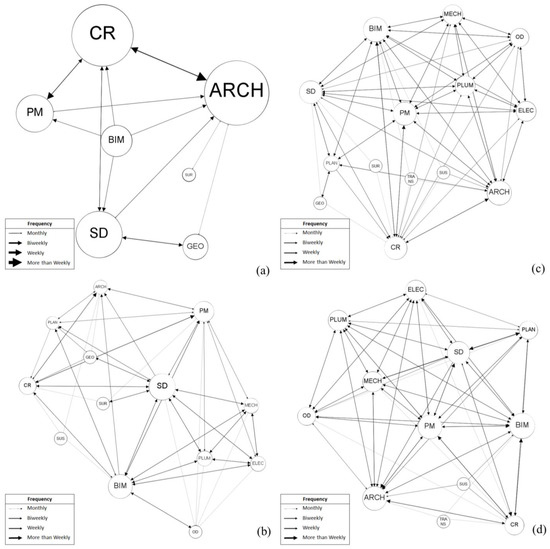
Figure 2.
Ideal interaction networks—Information flow: (a) Conceptual Design; (b) Preliminary Design; (c) Basic Design; (d) Detail Design.

Table 5.
Information flow network metrics.
In the conceptual design phase, 7 of the 14 identified roles are seen (50% of the design team), showing the importance of interactions and participants in the early stages of the design. On average, 1 person is connected to 3 others (density 0.476; mean degree of 2.86). In terms of quantity and frequency, the nodes with the greatest importance in the network are the architect and the construction company representative with a degree of 19 and 18, respectively. This makes great sense since, in the initial phases, the aim is to materialize the client’s requirements in the design, which is a crucial task of the architect. The BIM coordinator is a central element, an enabler of information, since he only has output interactions (he only delivers information).
In the preliminary design phase, 13 of the 14 identified roles participate (93% participation of the design team), which implies considerable growth concerning the previous phase. On average, 1 person is connected with 7 others (density 0.551; mean degree of 6.62), representing a significant growth in the previous phase. The nodes with the highest importance in the network are the structural designer and the BIM coordinator, with a weight degree of 58 and 52, respectively. After the first architectural conceptual design is completed, the role of the structural designer increases their presence and takes a central role in consolidating the structural components. There is a growing but peripheral presence of the BIM coordinator and project coordinator, emphasizing the flow of information with the MEP specialties.
In the basic design phase, all 14 identified roles participate (100% participation of the design team). On average, 1 person is connected with 7 others (density 0.571; mean degree of 7.43), representing a small growth concerning the previous phase. The nodes with the highest importance in the network are the BIM coordinator and the architect, with a weight degree of 59 and 58, respectively. The BIM coordinator continues with a role similar to that in the previous phase, while the architect takes on great relevance once again. The project coordinator acquires the central role, but a high flow is generally appreciated in all nodes.
Finally, 12 of the 14 roles were identified to participate in the detailed design phase (86% participation of the design team). In this phase, two roles are no longer required or end their participation: the geotechnical engineer and the topographer. On average, 1 person is connected to 9 others (density 0.773, mean degree of 8.5), which shows that the participants are connected to most of the roles that make up the network. The nodes with the highest importance in the network are the BIM coordinator, the architect, and the project coordinator, with a weight degree of 62, 58, and 58, respectively. The BIM coordinator and the architect maintain their relevance while the project coordinator continues to increase their rating in the network.
Figure 3 shows the degree distribution in terms of information flow throughout the design phases. The conceptual design presents low degree values, with low dispersion in terms of the interquartile range but with extreme values moderately far apart. The preliminary design shows an increase in degree values higher than the highest value of the previous phase. Although the range is similar to the previous one, the extreme values increase. There is an increase in the degree of basic design, but the dispersion of values also increases considerably. Finally, a compact box with little range and distribution is observed in the detailed design.
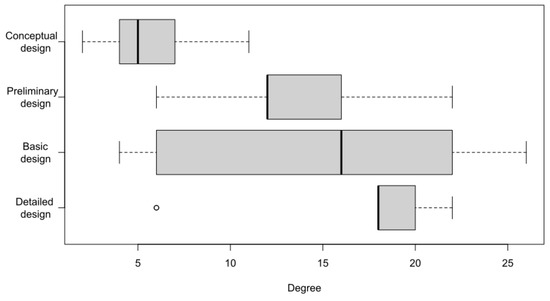
Figure 3.
Degree Distribution—Information flow. The circles are outlier points.
As the design develops, the relevant information shared among team members increases, and the frequency of this information being exchanged increases. This effect is generated in most of the roles since, as shown in Figure 4, in general, each role starts with a low level of interaction, which increases considerably in the intermediate phases and is then maintained or slightly reduced in the detailed design phase. Figure 4 showed that all roles have this behavior, e.g., the MEP engineers start with a 0% frequency of interaction in the conceptual design, then a 46% frequency of interaction in the preliminary design, then, next, a 62% frequency of interaction in the basic design, and finally, a 69% frequency of interaction in the detailed design.
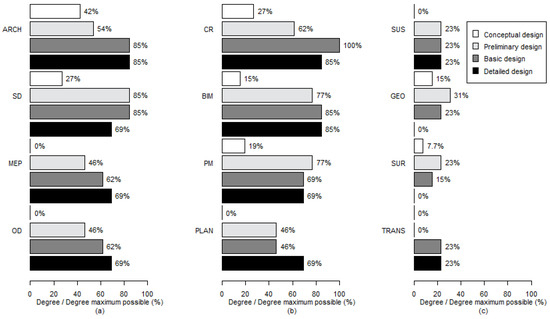
Figure 4.
Frequency of interaction by role—Information flow: (a) Design Roles; (b) Management Roles; (c) Other Roles.
In addition to this, a phenomenon is generated where at the beginning, the levels of interaction are low and similar among the participants, and then in the intermediate phases, the level of interaction increases. From Figure 4, it is possible to obtain the average and standard deviation of the frequency of interaction of every role in the team design. The average frequency of interaction starts at 12% in the conceptual design, then 46% in the preliminary design, then, next, 57% in the basic design, and 55% in the detailed design, demonstrating the increment in the average frequency of interaction. At the same time, the variability of the frequency of interaction rises in the life cycle of the design since the standard deviation in the conceptual, preliminary, basic, and detailed design is 13%, 25%, 27%, and 29%, respectively. In turn, there is a concentration of the levels of information, i.e., there are key nodes that carry the greatest weight of the flows (mainly the ARCH, CR, SD, BIM, and PM) and other nodes that contribute to a lesser extent (e.g., SUS, GEO, SUR, and TRANS). Finally, there is a high level of interaction that is not concentrated in any specific role, but, rather, all of the roles have high and similar levels of interaction.
3.3.2. Ideal Interaction Networks—Collaboration and Coordination
The collaboration and coordination networks (Figure 5) show the sociograms generated for each identified design phase. In this case, the networks were considered undirected, so there is no arrow indicating the frequency, but each edge has a label indicating this parameter, as shown in Table 2.
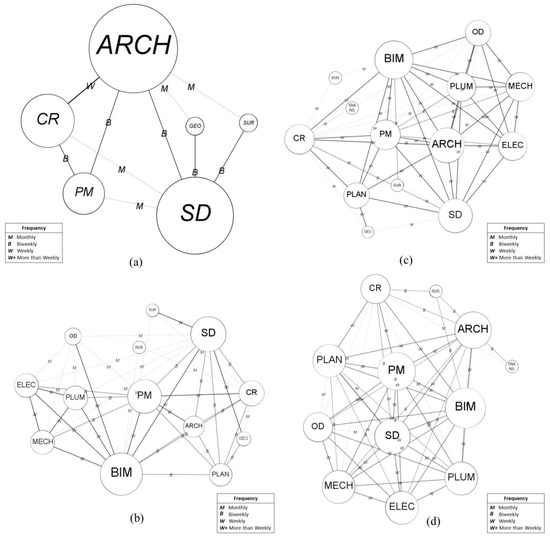
Figure 5.
Ideal interaction networks—Collaboration and coordination: (a) Conceptual Design; (b) Preliminary Design; (c) Basic Design; (d) Detailed Design.
In the conceptual design phase, 6 of the 14 identified roles participate (43% participation of the design team), which indicates that it is relevant to start with a significant number of participants in the design team at the beginning of the conceptual design phase. On average, 1 person is connected to 3 others (density 0.667; mean degree of 3.33). In terms of quantity and frequency, the nodes with the greatest importance in the network are the architect and structural designer with a degree of 18 and 16, respectively. The role of the BIM coordinator does not figure in the network, unlike the information flow network where he participated from the initial stage.
In the preliminary project design phase, we can visualize 13 of the 14 identified roles (93% participation of the design team), the same participation as in the information flow network. This implies considerable growth concerning the previous phase, incorporating seven new participants. On average, 1 person is connected to 6 others, which is twice as many as in the previous phase (density 0.526; mean degree of 6.31). The nodes with the highest importance in the network are the BIM coordinator and the structural designer with weight degrees of 52 and 42, respectively. The preponderant irruption of the BIM coordinator is given by the joint appearance of the MEP specialties. The structural designer continues his strong presence in the networks. At the same time, the project coordinator is the most central role in the network, thus taking on the role of an enabler of the collaborative processes.
In the basic design phase, it can be concluded that all 14 identified roles participate (100% participation of the design team). On average, 1 person is connected to 7 others (density 0.549; mean degree of 7.143), representing a small increase in the previous phase. The nodes with the highest importance are the BIM coordinator and the architect, with a weighted degree of 60 and 54, respectively. The former, like the previous phase, continues their presence while the architect takes relevance again in the collaborative processes. The central role is not entirely clear, distributing the network center between the project coordinator and the architect, but a high flow is generally appreciated in all nodes.
Finally, in the detailed design phase, it is possible to clarify that 12 out of 14 identified roles participate, which is 86% participation of the design team. On average, 1 person relates to 8 others (density 0.758; mean degree of 8.3). The nodes with the highest importance in the network are the BIM coordinator and the project coordinator, with weight degrees of 58 and 54, respectively.
Figure 6 shows the degree distribution in terms of collaboration and coordination. In the conceptual design phase, there are low average values of the grade, with medium dispersion in terms of the range but without extreme values. Then, in the preliminary design phase, there is an increase in the values of the grade, with a range similar to the previous one but with extreme values that are considerably distant. In the basic design phase, the grade increases, but the dispersion of values also increases considerably, both in terms of range and extreme values. Finally, a compact box is observed in the detail design phase with a short range and concentrated distribution but at least three outliers. Analyzing from a comparative perspective, this distribution is, to a large extent, similar to that of information flow networks.
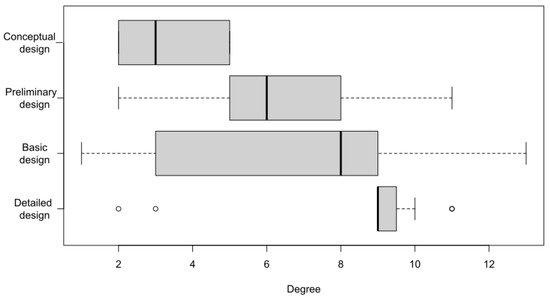
Figure 6.
Degree Distribution—Collaboration and Coordination. The circles are outlier points.
Like the information flow networks, in most roles, as the design develops, the collaborative design processes among the team members increase, and their frequency increases. Figure 7 shows that each role starts with a low level of interaction, which increases considerably in the intermediate phases and then is maintained or slightly reduced in the detailed design phase. In addition, in the beginning, the interaction levels are low in terms of links but high in participants. Then, in the intermediate phases, they increase and concentrate the level of interaction. Finally, a high level of interaction is not concentrated in any specific role, but all roles have similarly high levels of interaction.
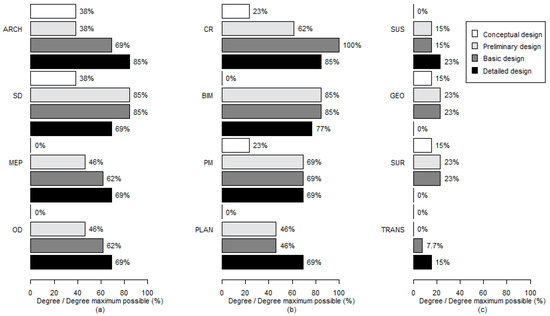
Figure 7.
Frequency of interaction by role—Collaboration and coordination: (a) Design Roles; (b) Management Roles; (c) Other Roles.
3.4. Proposal and Definition of Evaluation Metrics
3.4.1. The Adjusted Density of the Connections Required
This metric provides a proportional value of the number of ideal connections present in a real network, adjusted based on the connections of the ideal network. The evaluation ranges in values between zero and one, where values close to one indicate that the network under study is similar to the ideal network. Values close to zero indicate that the network does not approximate the ideal network (Equation (1)).
where is the adjusted density of the connection required; is the number of ideal connections present in a real network (number of connections in the network under study that match with a connection in the ideal network); and is the number of ideal connections in the ideal network.
In addition, this metric can be proposed for the case of weighted networks, which operate in the same way, following the same logic and evaluation range (Equation (2)).
where is the weight-adjusted density of the connection required; is the weight of the link “e” in the actual network; and is the weight of the link “E” in the ideal network.
3.4.2. The Adjusted Density of the Non-Required Connections
This metric provides a proportional value of the number of non-required connections of the network under study, adjusted based on the connections of the ideal network. The evaluation range is between zero and one, where values greater than or close to one indicate that the network under study has a high proportion of unnecessary connections. In contrast, values close to zero indicate that the network under study has a low proportion of unnecessary connections. Values equal to zero indicate that the network has no unnecessary connections (Equation (3)).
where is the adjusted density of the non-required connections; is the number of connections in the real network that are not in the ideal network; and is the number of ideal connections in the ideal network.
In addition, this metric can also be proposed for the case of weighted networks, which operate in the same way and with the same range of evaluation (Equation (4)).
where is the weight-adjusted density of the non-required connection; is the weight of the link “e” in the actual network; and is the weight of the link “E” in the ideal network.
3.4.3. The Adjusted Degree of Connections Required by Person
This metric provides a proportional value of the number of connections required for node “n” in the network under study, adjusted based on its connections in the ideal network. The evaluation range values between zero and one, where values close to one indicate that node “n” has ideal interactions and values close to zero indicate that node “n” does not have ideal interactions (Equation (5)).
where δa (n) is the adjusted degree of connections required; mr (n) is the number of ideal connections present in a real network of node “n”; and Mi (n) is the number of ideal connections in the ideal network of node “n”.
In addition, this metric can also be proposed for the case of weighted networks, which operate in the same way and with the same evaluation range (Equation (6)).
where is the weight-adjusted degree of connections required; is the weight of the ideal link “e” in the actual network of node “n”; and is the weight of the ideal link “E” in the ideal network of node “n”.
3.4.4. The Adjusted Degree of Connections Not Required by Person
This metric provides a proportional value of the number of non-required connections presented by node “n”, adjusted based on the total of its connections. The evaluation range indicates that with values greater or close to one, the node “n” presents a high proportion of unrequired connections, and for values close to zero, the node “n” presents a low proportion of unrequired connections. Values equal to zero indicate that the node “n” does not present non-required connections (Equation (7)).
where is the adjusted degree of connections not required by a person; is the number of non-required connections in the actual network of the node “n”; and is the outdegree of the node “n” (directed networks) or degree of the node “n” (undirected networks).
In addition, this metric can also be proposed for the case of weighted networks, which operate in the same way with the same evaluation range (Equation (8)).
where is the weight-adjusted degree of connections not required by a person; is the weight of the non-required link “e” in the actual network of the node “n”; and is the weight outdegree of the node “n” (directed networks) or the weight degree of the node “n” (undirected networks).
4. Pilot Cases
The networks involved two design teams in the design phase, one with a BIM/lean approach and one without this approach (traditional approach). The developed networks are presented in Figure 8 (BIM/lean approach) and Figure 9 (traditional approach).
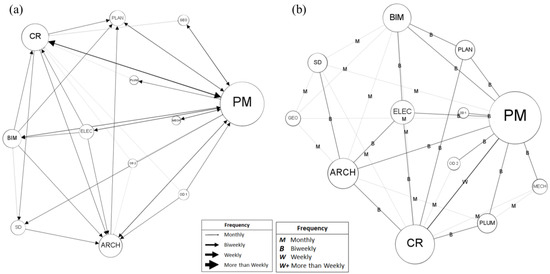
Figure 8.
BIM/Lean approach: (a) Information flow network; (b) Collaboration network.
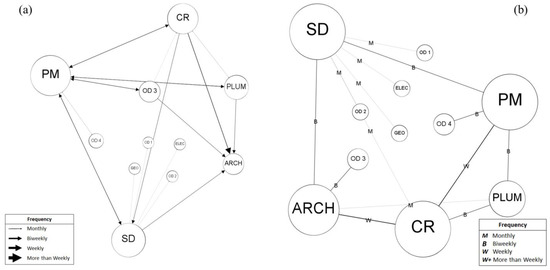
Figure 9.
Traditional approach: (a) Information flow network; (b) Collaboration network.
4.1. Evaluation of Information Flow Networks: BIM/Lean and Traditional Approach
Table 6 presents the overall metrics of the networks under study and the ideal network in the detailed design phase. In terms of SNA, when comparing the pilot cases with the ideal network, both are considerably different from the ideal network. This is because they are different in a notorious proportion to the metrics of the ideal model when evaluating the metrics. For example, the ideal mean degree is more than twice that obtained in the BIM/lean approach cases and more than four times that of the traditional approach, which means that each node connects to less than half of the ideally required number in the evaluated network’s nodes. On the other hand, the diameter is identical in the BIM/lean network and the ideal model, with a value of 2, while in the network with the traditional approach, a value of 3 is presented. This follows in line with the bottleneck detected in the level 1 comparison. Both cases are lower than the ideal density in terms of the network density; therefore, the ideal condition responds to a dense network (high number of edges, close to the maximum), while the two pilot sociograms are rather sparse networks (low number of edges). Finally, the average path length indicates that in the ideal condition, it takes, on average, little more than one step to connect any pair of nodes in the network, while in the pilot networks, it takes about two steps. Both networks do not resemble the ideal condition when evaluating SNA metrics. Thus, detecting a considerable lack of links between the networks’ nodes impacts the evaluated metrics. However, in absolute terms, the BIM/lean approach network is closer to the ideal condition than the traditional approach network.

Table 6.
SNA metrics comparison—information flow.
Evaluating the proposed metrics (Table 7), in terms of the global adjusted density, the BIM/lean approach network represents twice the value of the traditional approach network. In terms of rank, values close to 1 indicate that the network resembles the ideal network, indicating that the BIM/lean approach network is closer to the ideal model than the traditional approach network. However, the values are considerably low; therefore, no test network is ideal. When evaluating the density of non-required connections, the values are low in both approaches, so there are not many non-required connections. The problem lies in a significant absence of ideal connections rather than non-required connections. The analysis is consistent when evaluating the metrics considering the weights.

Table 7.
Global proposed metrics—information flow.
For the case of the individual metrics, when analyzing the adjusted degree of connections required by a person, no case is similar enough to the ideal conditions, except for the role of project coordinator, which presents a value identical to the ideal and 60% when considering the frequency; however, in practical terms, the project with the BIM/lean approach is closer to the state of ideal conditions (Figure 10). The network with the BIM/lean approach presents characteristics more similar to the ideal condition than the network with the traditional approach. Thus, as shown in Figure 10, the BIM/lean value distribution is moderately superior to that of the traditional approach. This difference increases when considering the weights of the connections, where the network with the BIM/lean approach presents values closer to 1.
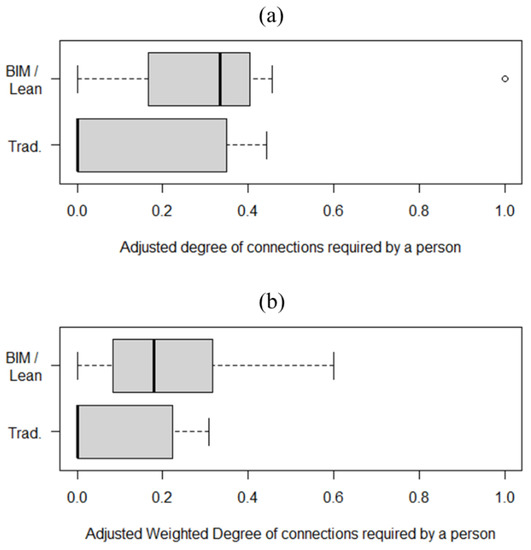
Figure 10.
Adjusted degree distribution—information flow: (a) Adjusted degree; (b) Weighted-adjusted degree. The circles are outlier points.
When studying the metrics of connections not required (Table 8), it can be seen how the roles with some unnecessary connections are present to a greater extent in the network with the BIM/lean approach. However, for both approaches, the values obtained are not extremely high (except for the case of the geotechnical engineer, whose presence could be due to a particularity of the studied project), i.e., none of their interactions contribute in a real way to the design process under the proposed ideal condition. On the other hand, the client’s representative presents 20% of connections not required (10% if weights are considered), i.e., this role presents an excess of participation in this phase or is connecting with roles that it should not. In addition, in the traditional approach network, the only role that has not required connections is the structural designer, with 17% of its interactions, which may be because, in the absence of a coordinator, one of the designers assumes this role, which may lead to bottlenecks or other negative effects on the flow of information.

Table 8.
Metrics non-required connections—information flow.
4.2. Evaluation of BIM/Lean and Traditional Approach Collaboration Networks
Evaluating the proposed metrics (Table 9), it is noted that, in terms of the overall adjusted density, the BIM/lean approach network represents twice the value of the traditional approach network, indicating that the BIM/lean approach network is closer to the ideal model than the traditional approach network. However, the values are notoriously low, so none of the test networks resembles the ideal model in practical terms. When evaluating the density of unnecessary connections, the values are low in both approaches, so it is estimated that there are not many connections that are not required. The analysis is logically consistent when evaluating the metrics with weights.

Table 9.
Global proposed metrics—collaboration.
For the case of the individual metrics, it can be observed how, when analyzing the adjusted degree of connections required by a person in both cases, none is similar enough to the ideal conditions, except for the project coordinator, the BIM coordinator and the representative of the client in the network with the BIM/lean approach, which present values close or equal to 1, so it can be considered that their state is quite close to the ideal. Nevertheless, this does not hold when analyzing this metric considering the weights, so there is a problem in the frequency of interaction rather than in the number of interactions. Being rigorous, the project with the BIM/lean approach is closer to the ideal condition state. Figure 11 shows the distribution of the adjusted degree. It can be identified how the network with the BIM/lean approach presents characteristics more similar to the ideal condition than the network with the traditional approach. The distribution of BIM/lean values (Figure 11) is moderately superior to that with the traditional approach, which is maintained when studying this metric considering the interaction frequencies. However, when studying the distribution with weights, both approaches move away from the ranges that allow one to consider the network similar to the ideal model, presenting values considerably far from 1.
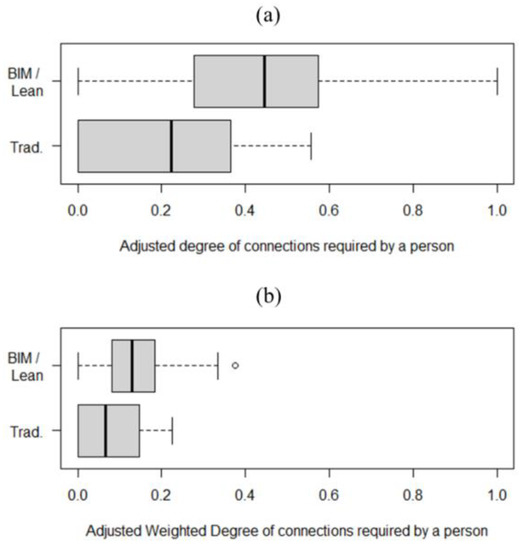
Figure 11.
Adjusted degree distribution—collaboration: (a) Adjusted degree; (b) Weighted-adjusted degree. The circles are outlier points.
5. Conclusions
The most relevant interactions to measure in building design teams are information flow, collaboration, coordination, trust, and role identification. There are at least fourteen key or recurring roles. These roles were key for a high-rise building design project located in an urban area. It is important to mention that the definition of “role” in this research does not necessarily mean a function assumed by a single person within the design team in a real project. The study demonstrates a positive correlation between traditional social network analysis (SNA) metrics and the metrics introduced in this research, with the ideal metrics serving as the foundational basis. However, the proposed metrics offer the additional capability to assess the degree of divergence between a design team’s current interactions and those required or ideal, providing a sense of urgency. As a result, this study enables portfolio, program, and project managers to determine whether the interaction network of their project, encompassing information flow and collaboration, aligns with the predefined conditions in the project configuration. Such insights cannot be obtained through traditional SNA metrics alone. However, configuring the interaction networks of a project is a responsibility assigned to the project team or can be facilitated by the metrics proposed in this study. It is important to acknowledge that the project design team and its conditions may not necessarily remain static, thus requiring ongoing evaluation and adaptation.
The ideal structure of interactions in terms of information flow increases throughout the design (more participating roles are incorporated). However, from the initial design stage, about 50% of the participants are required, with many missing roles being added in the next phase and then in the basic design, momentarily including all of the defined roles. Similarly, the ideal structure of interactions in terms of collaboration and coordination is increasing throughout the design process. In this case, about 43% of the participants are required from the initial design stage, increasing towards the final stages of the design, where high volumes of interaction are generated equitably among all roles.
In terms of the frequency of interaction, the ideal flow of information in the initial design phase should be mostly fortnightly. Then, this frequency should be mostly weekly from the basic design onwards. A similar case occurs in the ideal interaction frequency of the collaboration and coordination processes. At the beginning of the design, the frequency should be between fortnightly and monthly. They tend to consolidate into a weekly interaction frequency in the final phases of the design (basic and detailed). A similar scenario occurs when analyzing the behavior of individual nodes.
On the other hand, in the case of information flow, the management roles have high levels of interaction from the preliminary design stage, which is consolidated and maintained in subsequent phases, while in general, the design roles have high levels of interaction starting from the detailed design stage. This leads to the conclusion that in the initial stages, design management processes are required to a greater extent to allow the designers’ adequate and efficient entry. This scenario is repeated identically in the collaboration networks; therefore, it can be deduced that in design, the collaboration processes in earlier stages are mainly enabled by the management roles.
Considering the results and analysis, the proposed comparison tool allows us to evaluate the current state of a building project based on the ideal networks and allows us to perform a comparative analysis between different projects and evaluate which one most closely resembles the ideal interaction conditions. Although the research aimed to propose the ideal framework of interactions for two cases (information flow and collaboration and coordination), at least two other types of interaction were left out of this construction of ideal scenarios: trust and role identification. These networks were not addressed, leaving open a powerful future line of research in developing and constructing ideal networks for the rest of the relevant interactions validated in this research. On the other hand, the ideal framework proposed by these two groups of constructed networks was based on the definition of a specific design project, “design of a high-rise building located in an urban area”, so it is not possible to ensure its applicability in any variation of this type of project or its relevance for types of projects other than buildings.
Author Contributions
Conceptualization, R.F.H. and E.I.G.-D.; methodology, R.F.H.; software, E.I.G.-D.; validation, T.C., F.M.-L.R. and E.A.; formal analysis, E.I.G.-D.; resources, R.F.H.; writing—original draft preparation, E.I.G.-D.; writing—review and editing, E.A. and T.C.; visualization, F.M.-L.R.; supervision, R.F.H. and E.A.; project administration, R.F.H.; funding acquisition, R.F.H. All authors have read and agreed to the published version of the manuscript.
Funding
This research was funded by FONDECYT INICIACION 2023, grant number 11230455. The APC was funded by Pontificia Universidad Católica de Valparaíso.
Data Availability Statement
No new data were created or analyzed in this study. Data sharing is not applicable to this article.
Acknowledgments
The authors wish to thank the TIMS space (Technology, Innovation, Management, and Innovation) of the School of Civil Engineering of the Pontificia Universidad Católica de Valparaíso (Chile) where the research was carried out.
Conflicts of Interest
The authors declare no conflict of interest.
References
- Oluwatayo, A.A.; Amole, D. Ownership, Structure, and Performance of Architectural Firms. Front. Archit. Res. 2013, 2, 94–106. [Google Scholar] [CrossRef]
- Elmualim, A.; Gilder, J. BIM: Innovation in Design Management, Influence and Challenges of Implementation. Archit. Eng. Des. Manag. 2014, 10, 183–199. [Google Scholar] [CrossRef]
- Koolwijk, J.S.J.; van Oel, C.J.; Gaviria Moreno, J.C. No-Blame Culture and the Effectiveness of Project-Based Design Teams in the Construction Industry: The Mediating Role of Teamwork. J. Manag. Eng. 2020, 36, 04020033. [Google Scholar] [CrossRef]
- Dainty, A.R.J.; Briscoe, G.H.; Millett, S.J. Subcontractor Perspectives on Supply Chain Alliances. Constr. Manag. Econ. 2001, 19, 841–848. [Google Scholar] [CrossRef]
- Love, P.E.D.; Irani, Z.; Cheng, E.; Li, H. A Model for Supporting Inter-Organizational Relations in the Supply Chain. Eng. Constr. Archit. Manag. 2002, 9, 2–15. [Google Scholar] [CrossRef]
- Ren, Z.; Anumba, C.J.; Yang, F. Development of CDPM Matrix for the Measurement of Collaborative Design Performance in Construction. Autom. Constr. 2013, 32, 14–23. [Google Scholar] [CrossRef]
- Reiter-Palmon, R.; Leone, S. Facilitating Creativity in Interdisciplinary Design Teams Using Cognitive Processes: A Review. Proc. Inst. Mech. Eng. Part C J. Mech. Eng. Sci. 2019, 233, 385–394. [Google Scholar] [CrossRef]
- Baiden, B.K.; Price, A.D.F.; Dainty, A.R.J. The Extent of Team Integration within Construction Projects. Int. J. Proj. Manag. 2006, 24, 13–23. [Google Scholar] [CrossRef]
- Ng, S.; Tang, Z. Labour-Intensive Construction Sub-Contractors: Their Critical Success Factors. Int. J. Proj. Manag. 2010, 28, 732–740. [Google Scholar] [CrossRef]
- Hickethier, G.; Tommelein, I.D.; Lostuvali, B. Social Network Analysis of Information Flow in an IPD-Project Design Organization. In Proceedings of the 21st Annual Conference of the International Group for Lean Construction 2013, IGLC 2013, Fortaleza, Brazil, 29 July–2 August 2013; Volume 1, pp. 315–324. [Google Scholar]
- Herrera, R.F.; Mourgues, C.; Alarcón, L.F.; Pellicer, E. Understanding Interactions between Design Team Members of Construction Projects Using Social Network Analysis. J. Constr. Eng. Manag. 2020, 146, 04020053. [Google Scholar] [CrossRef]
- Moum, A. Design Team Stories: Exploring Interdisciplinary Use of 3D Object Models in Practice. Autom. Constr. 2010, 19, 554–569. [Google Scholar] [CrossRef]
- Guerra, A.L.; Gidel, T.; Kendira, A.; Vezzetti, E.; Jones, A. Co-Evolution of Design Tactics and CSCWD Systems: Methodological Circulation and the TATIN-PIC Platform. In Proceedings of the 19th International Conference on Engineering Design (ICED13), Seoul, Republic of Korea, 19–22 August 2013; Volume 9 DS75-09, pp. 315–324. [Google Scholar]
- Cash, P.; Dekoninck, E.A.; Ahmed-Kristensen, S. Supporting the Development of Shared Understanding in Distributed Design Teams. J. Eng. Des. 2017, 28, 147–170. [Google Scholar] [CrossRef]
- Zanni, M.A.; Soetanto, R.; Ruikar, K. Towards a BIM-Enabled Sustainable Building Design Process: Roles, Responsibilities, and Requirements. Archit. Eng. Des. Manag. 2017, 13, 101–129. [Google Scholar] [CrossRef]
- Schöttle, A.; Haghsheno, S.; Gehbauer, F. Defining Cooperation and Collaboration in the Context of Lean Construction. In Proceedings of the 22nd Annual Conference of the International Group for Lean Construction: Understanding and Improving Project Based Production, IGLC 2014, Oslo, Norway, 25–27 June 2014; Kalsas, B.T., Koskela, L., Smith, T.A., Eds.; The International Group for Lean Construction: Karlsruhe Institute of Technology (KIT), Institute of Technology and Management in Construction (TMB): Karlsruhe, Germany, 2014; pp. 1269–1280. [Google Scholar]
- Herrera, R.F.; Mourgues, C.; Alarcón, L.F.; Pellicer, E. Comparing Team Interactions in Traditional and BIM-Lean Design Management. Buildings 2021, 10, 447. [Google Scholar] [CrossRef]
- AIA. Integrated Project Delivery: A Guide; AIA: Sacramento, CA, USA, 2007; Volume 1. [Google Scholar]
- Wang, K.; Xue, Y.; Guo, Q.; Shahidehpour, M.; Zhou, Q.; Wang, B.; Sun, H. A Coordinated Reconfiguration Strategy for Multi-Stage Resilience Enhancement in Integrated Power Distribution and Heating Networks. IEEE Trans. Smart Grid 2023, 14, 2709–2722. [Google Scholar] [CrossRef]
- Yang, H.-L.; Tang, J.-H. Team Structure and Team Performance in IS Development: A Social Network Perspective. Inf. Manag. 2004, 41, 335–349. [Google Scholar] [CrossRef]
- Alarcón, D.M.; Alarcón, I.M.; Alarcón, L.F. Social Network Analysis: A Diagnostic Tool for Information Flow in the AEC Industry. In Proceedings of the 21st Annual Conference of the International Group for Lean Construction 2013, IGLC 2013, Fortaleza, Brazil, 29 July–2 August 2013; The International Group for Lean Construction—Centre of Excellence in Production Management, GEPUC, Pontificia Universidad Católica de Chile: Santiago, Chile, 2013; pp. 196–205. [Google Scholar]
- Castillo, T.; Alarcón, L.F.; Salvatierra, J.L. Effects of Last Planner System Practices on Social Networks and the Performance of Construction Projects. J. Constr. Eng. Manag. 2018, 144, 05017120–05017121. [Google Scholar] [CrossRef]
- Galaz-Delgado, E.I.; Herrera, R.F.; Atencio, E.; La Rivera, F.M.; Biotto, C.N. Problems and Challenges in the Interactions of Design Teams of Construction Projects: A Bibliometric Study. Buildings 2021, 11, 461. [Google Scholar] [CrossRef]
- Kereri, J.O.; Harper, C.M. Social Networks and Construction Teams: Literature Review. J. Constr. Eng. Manag. 2019, 145, 03119001. [Google Scholar] [CrossRef]
- Herrera, R.F.; Alarcón, L.F. Social Network Analysis to Support Implementation and Understanding of Lean Construction. In Lean Construction 4.0—Driving a Digital Revolution of Production Management in the AEC Industry; González, V.A., Hamzeh, F., Alarcón, L.F., Eds.; Routledge: London, UK, 2022; pp. 157–172. [Google Scholar]
- Flores, J.; Ruiz, J.C.; Alarcón, D.; Alarcón, L.F.; Salvatierra, J.L.; Alarcón, I. Improving Connectivity and Information Flow in Lean Organizations—Towards an Evidence-Based Methodology. In Proceedings of the 22nd Annual Conference of the International Group for Lean Construction 2014, IGLC 2014, Oslo, Norway, 25–27 June 2014; International Group for Lean Construction: Oslo, Norway, 2014; pp. 1109–1120. [Google Scholar]
- Al Hattab, M.; Hamzeh, F. Using Social Network Theory and Simulation to Compare Traditional versus BIM-Lean Practice for Design Error Management. Autom. Constr. 2015, 52, 59–69. [Google Scholar] [CrossRef]
- Planbim (CORFO). Estándar BIM Para Proyectos Públicos; Planbim: Santiago, Chile, 2021. [Google Scholar]
Disclaimer/Publisher’s Note: The statements, opinions and data contained in all publications are solely those of the individual author(s) and contributor(s) and not of MDPI and/or the editor(s). MDPI and/or the editor(s) disclaim responsibility for any injury to people or property resulting from any ideas, methods, instructions or products referred to in the content. |
© 2023 by the authors. Licensee MDPI, Basel, Switzerland. This article is an open access article distributed under the terms and conditions of the Creative Commons Attribution (CC BY) license (https://creativecommons.org/licenses/by/4.0/).